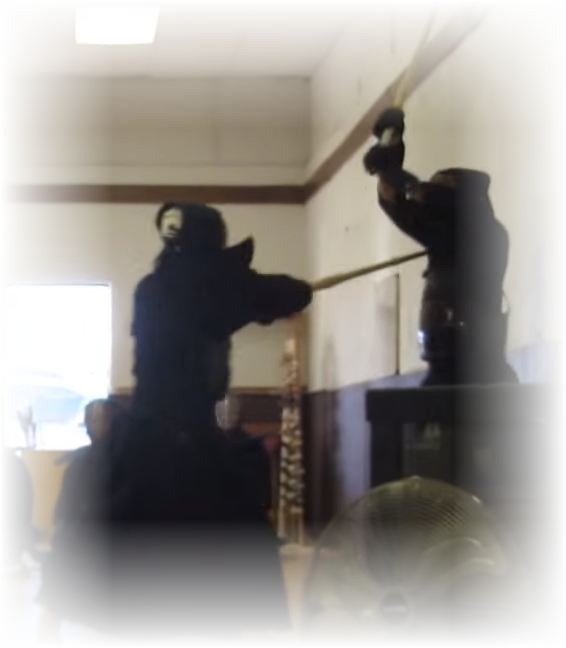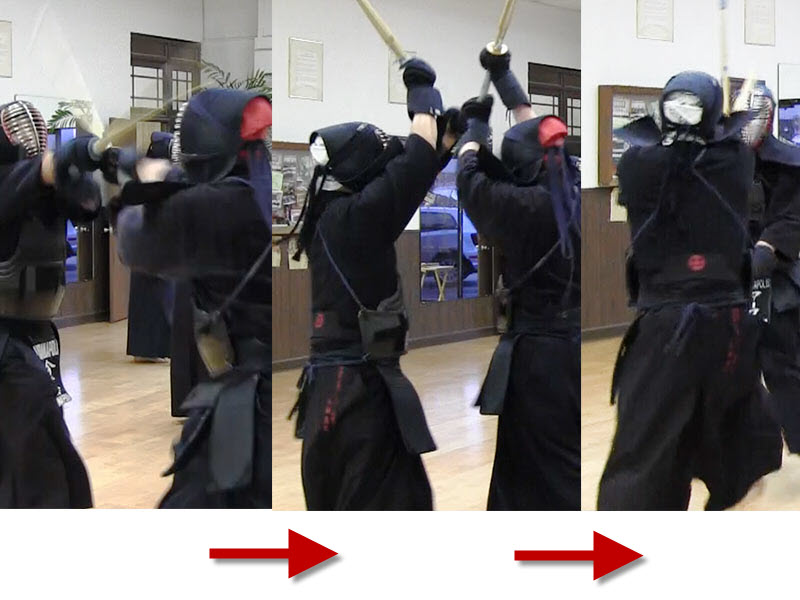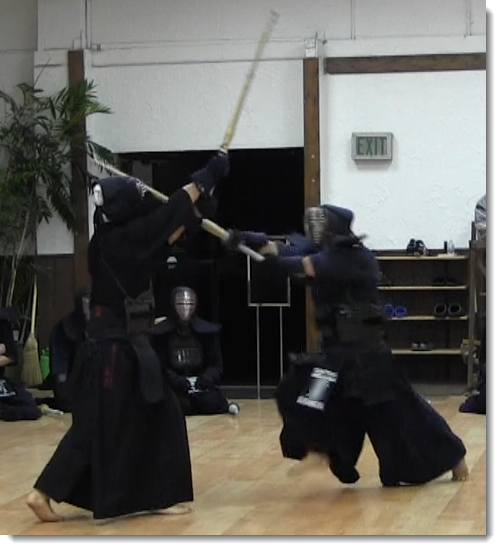You Got It!
Three Opportunities to Strike
 Tsuki on Hiki Men (An Opportunities to Strike)
Tsuki on Hiki Men (An Opportunities to Strike)Would it be great to know when to strike? I will tell you when to strike. There’re three opportunities to strike in kendo. We call it, Mittsu no Yurusanu Tokoro (three opportunities that you do not allow to miss) or Mittsu no Utsubeki Tokoro (three opportunities that you should strike).
Three Opportunities to Strike
- When your opponent is just about to strike (Deyōtosuru tokoro)
- When your opponent is done striking (Waza no tsukita tokoro)
- When your opponent is in the state of itsuki (Itsuita tokoro)
Just about to Strike
You
might have heard a word, degashira. This is a state of your opponent when he/she is just about to strike. For example, de-kote.
Your opponent is just about to strike
your men. The tip of the sword or kensaki
comes up. And your opponent’s right hand will open for you to strike his/her kote .
This sounds easy enough to do but if you react to your opponent’s men, in this case, your kote strike won’t be successful. You’ll probably get struck. Here is the key to successful degarashira techniques.
- Put pressure to your opponent so your opponent has no choice but strike
Mentally you corner your opponent so your opponent has nowhere to go but comes forward and strike you.
Because you are in control, you know your opponent is coming to strike you. So the rest is easy. You just get him/her.
When Your Opponent is Done Striking
 Strike -> Eyes on Opponent -> Chase and Strike
Strike -> Eyes on Opponent -> Chase and StrikeHave your sensei or sempai (senior students) struck you when you were just about to turn around after you were done with your strike and passed through?
Have your opponent struck you when you stopped after you executed a strike?
Do you know why they could get you?
That is because you relaxed after your strike.
When you are executing strikes, you are energized and focusing on your targets you’re striking. But after you are done with striking, you take a moment or break. In other words, you lose your concentration.
This is another example. You strike and get into tsubazeri-ai. You are just about to get into the position of your tsubazeri-ai, your opponent executes a hiki waza (techniques executed while stepping backward).
You might not think you are relaxed there but your mind is getting ready to do tsubazeri-ai. There is a blank moment because the attacking mode is switched off before getting into tsubazeri-ai and the tsubazeri-ai mode is just about to take place. Make sense?
This is a great moment you strike. Easy to say, I know :)
State of Itsuki
If you have not heard of the term, itsuki, that’s’ fine. Basically your mind goes blank and thus your body freezes. So you cannot react to your opponent. S/he gets you off guard.
There’re several situations when this happens.
- You didn’t expect your opponent’s certain behavior (surprise). This includes that your opponent’s did not do anything tricky, just came at you straight and got you
- You just froze because the pressure from your opponent overwhelmed you; just like a frog in front of a snake (fear).
- You simply didn’t know what to do as a result of thinking too much (confused).
- Your opponent’s made you panic, i.e. you did not know what would happen. For example, you thought your opponent would come for your men so you lifted your hands up to guard but you got hit on your kote.
- You started retreating by leaning backwards but it was too late and could not do anything
* You can read 4 sicknesses or shikai for better understandings about the states of mind.
Which One Is Best For You To Try?
 Striking the Left Men While Blocking the Right Side
Striking the Left Men While Blocking the Right SideTry to strike your opponent when your opponent is done striking and when your opponent is blocking. You can practice these two right away. Believe me, these work wonderfully.
Most of the time, you probably strike when your opponent comes closer to you. Almost you react to your opponent every time he/she moves. That is a great way to learn degashira, i.e. strike when your opponent is just about to strike you.
But that is the moment you probably should not strike ALL the time. Don’t have an experience of hitting each other because you and your opponent always strike at the same time?
No.1 Advice: Don’t strike when your opponent’s striking you.
That is not the same as degashira. You must know the difference.
In degashira, you strike your opponent when your opponent is just about to execute a technique. That means you strike your opponent even before he/she launches their strike.
If you want to defeat your opponent with degashira techniques not by accident, then you’ve got to practice how you can control your opponent too. You have to set your opponent up so they will strike your men but you will strike their kote as soon as they come and execute their men strike on you. They do not know it is a trap!
That is also why it is hard for beginners to do.
Did you notice that those three opportunities to strike are when your opponent is not striking? That makes sense, doesn’t it?
Remember that you execute techniques when your opponent is vulnerable to your techniques.
Hope this helps!

